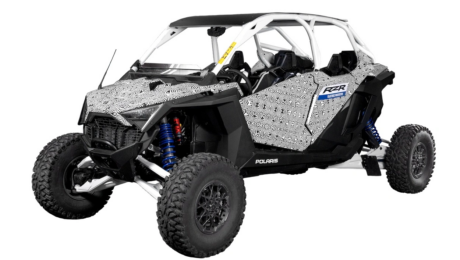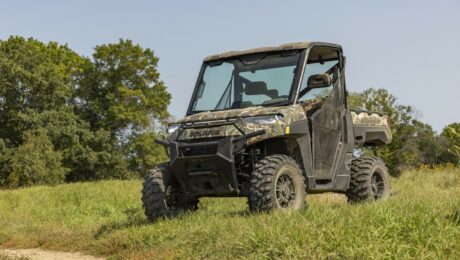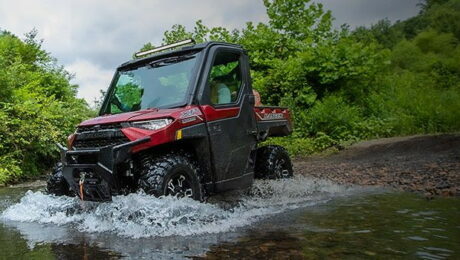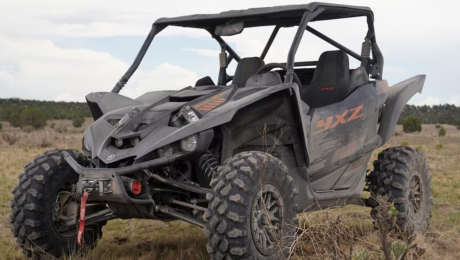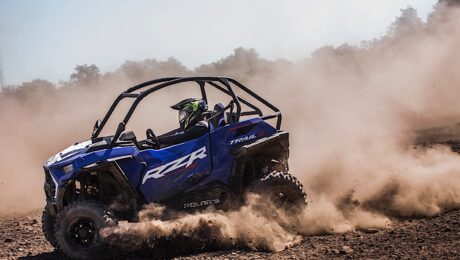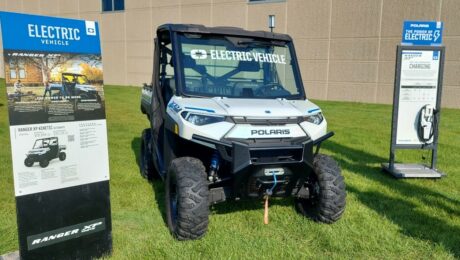Polaris shows off test vehicles for electric ATVs, RZR side-by-side, and even electric snowmobile
Polaris isn’t simply paying lip service when it talks about the future of electrification in powersports. The Minnesota-based leader in powersports vehicles has already unveiled its first next-gen electric UTV and now has shown off several test vehicles for electric Polaris ATVs, side-by-sides, and snowmobiles.
Last year was full of carefully titrated leaks and teasers surrounding the highly anticipated all-new electric RANGER UTV from Polaris.
The work was made possible through a partnership with Zero Motorcycles that saw Zero’s electric powertrain combined with Polaris’s vehicle expertise and is expected to result in even more models in the future.
Unveiled in December as the new RANGER XP Kinetic, the new model was described by Polaris as the most powerful UTV on the market, gas or electric. Polaris is set to begin deliveries this year after the new EV sold out within hours of its launch.
Polaris certainly sees electrification as part of its growth strategy, as the company explained:
We listen and learn directly from our customers to deliver high-quality products, experiences, and services that matter most to them. While innovation has been part of our DNA from the beginning, our electrification and connected vehicle initiatives represent an incredible opportunity to exceed customers’ expectations in powersports and the recent launch of the Ranger XP Kinetic is the first example of how we plan to lead in these areas.
But the company isn’t stopping there. At a recent investor meeting, Polaris revealed additional images of electric test vehicles that could represent the next stage in electrification at Polaris.
Despite making it clear that these were test vehicles and “not vehicles that Polaris has committed to bring to market at this time,” it’s quite obvious that Polaris is at least keenly interested in exploring the direction.
Among the test electric vehicles shown off in the investor presentation were electric ATVs for both the adult and youth markets, an electric RZR side-by-side, and an electric snowmobile.
These vehicles would greatly expand Polaris’s electric focus from purely utility vehicles to more recreational and dual-use vehicles.
Read more: Polaris shows off test vehicles for electric ATVs, RZR side-by-side, and even electric snowmobile
- Published in Industry News
Driven: 2023 Polaris Ranger XP Kinetic, a Truly Game Changing Electric Side-By-Side UTV
It’s an all-electric side-by-side UTV that can replace your pickup truck out in the fields while simultaneously being so much fun it feels like it shouldn’t be legal. The new Ranger XP Kinetic is by no means the effort of a single company. It’s the particularly fruitful result of a collaboration begun in 2020 between Polaris and one of the fastest-rising forces in American electric motorbikes, Zero Motorcycles.
As we can now attest, these two parties joining forces can create some real fireworks. The Polaris R&D Proving Grounds, in a small town outside Minneapolis, Minnesota, served as a fitting playground. As you’d expect it to be. Just look at who owns this property. On the grass outside the vast facility’s main office building was a fleet of new Ranger XP Kinetics for us to play with. Before we set off, Polaris personnel spoke with the press on site about their eagerness to prove they could fulfill the needs of their native gasoline-powered loving clientele and people desiring an electric alternative.
As mentioned above, the heart and soul of the Kinetic XP is a Zero Motorcycles-derived battery-EV powertrain that shares a large degree of functionality with their proprietary brushless DC electric motorcycle powertrains. In short, it’s 15 years’ worth of experience in lightweight electric drivetrains pairing up with an industry leader in 4×4 UTVs and off-road vehicles. The results of their efforts are nothing short of profound.
Polaris comes out of the gate strong with a special drivetrain energy rating of 28.9 kWh on the battery specifically for the top-of-the-line Ranger UTV application. Models lower down in the model lineup settle for a 14.9 kWh unit, both are lithium-ion batteries. The estimated battery range from full to zero for either package of 80 miles (128.75 km) with the Ultimate and 40 miles (64.3 km) with lower trims beats many highway-approved passenger EVs from only a handful of years ago.
Charge times to full vary depending on your choice of level one or two charging systems, and choice of 120 or 240-volt power outlets. Times range between 3.5 and 20 hours depending on these factors. The performance figures are nothing at all to sneeze at, either. With 110 horsepower on offer alongside 140 lb-ft (189 Nm) of instantly available torque in such a light body, road-legal subcompacts exist on the market in 2022 with far less power.
What does that translate to out in the dirt, sand, and gravel of the Minnesota forest? Well, if the fastest, meanest-looking thing you’ve ever driven is a crossover SUV, it both feels and looks like the fastest and most badass-looking thing you’ve ever driven in your life. It’s immediately obvious within the first few seconds of looking at the Kinetic KPs front fascia that it’s an electric vehicle. With smooth, sculpted plastic taking the place of grille slits for the engine’s radiator makes for an exterior that fits into the family tree quite well. All while remaining unique and special looking with its little, subtle changes. As it turns out, those little things add up fast.
Climbing inside this electric UTV reveals a remarkably more automotive-looking interior than anyone who’s only ever driven a car could have ever guessed. Sitting inside the cabin of the Kinetic XP could be a mind-blowing experience if you were expecting something more spartan. Plush foam bench seats are accented in a supple but durable vinyl material that almost tricks the brain into thinking you’re in a normal car.
Read more: Driven: 2023 Polaris Ranger XP Kinetic, a Truly Game Changing Electric Side-By-Side UTV
- Published in Industry News
2022 Ranger XP 1000 NorthStar Edition Is a Whole New Kind of Off-Road Beast
Polaris just dropped the new Ranger SP 570 line-up that brings something for everybody, from 2-seaters to special editions, all boasting upgrades for even better mid-size UTV (utility terrain vehicle) capabilities. For those who expect the best, the jewel in the crown comes in 2 trims that give the words “trail boss” a whole new meaning.
One of the chances you have to take when going off-road is getting yourself exposed to water, dust and debris. But not if you’re riding in the Ranger NorthStar Edition Premium, which is built with a tight sealing cab system that effectively keeps all of that away. Not to mention that this factory-installed Pro Shield system also keeps away the noise, making for more pleasant rides.
The Ranger NorthStar is also built for maximum protection, fending off rocks or stumps and handling rough terrain, thanks to the rigid one-piece chassis, full-body skid plate with 14” of ground clearance, and impressive front bumper. Like any champion, it boasts unmatched power and capability. The 999cc ProStar engine delivers 82 Hp, with 2,500 lb towing and 1,500 lb payload capacity.
Stepping inside, you’ll be pleasantly surprised by the premium HVAC with a variable AC compressor that quickly cools or raises temperatures, for all-season comfort. Add to that new, contoured seats that are designed for extra-comfort, and you’ve got one of the best trail companions out there.
If you want to step it up a notch, the Ultimate trim comes with Ride Command, a 7″ infotainment system that includes speakers, cameras, GPS mapping and other features that come in handy when you’re off the road. The Ultimate is just as powerful as the Premium, but adds 29″ 8-ply Pro Armor X-Terrain tires, for those extra heavy-duty tasks.
Read more: 2022 Ranger XP 1000 NorthStar Edition Is a Whole New Kind of Off-Road Beast
- Published in Industry News
Yamaha YXZ 1000R SS Review: The Sequential Paddle Shifters Every Side-By-Side Deserves
A unique cross-promotional event at Gunsite Academy in Arizona this summer put on by Glock, Nosler, Shoot United, and Yamaha Motorsports brought together a combination of journalists from the firearms, outdoor adventure, and automotive industries. As much fun as I had during the John Wick-style firearms training, my real job at Gunsite involved testing out every model in the Yamaha UTV lineup, highlighted by the high-performance YXZ side-by-side.
Unlike most SxS manufacturers, Yamaha eschews the more easily accessible CVT automatic transmission in favor of a sequential gearbox on the YXZ. Controlled via paddle shifters that allow the YXZ 1000R SS’s inline triple to rev right up to 12,000 RPMs, the sequential setup left me grinning from ear to ear after the first lap around Gunsite’s extensive compound.
Glock, Nosler, and Shoot United brought the fun factor, without a doubt, and our group of journalists learned a ton about firearm safety during quick-draw technique exercises. Then, Yamaha pulled out the UTV lineup to show off the capabilities of the YXZ, Grizzly ATV, and the Wolverine in R Max, X2, and X4 layouts. While the fun Grizzly and more utilitarian Wolverines do employ a CVT, the YXZ drew my full attention simply because of that sequential shifter.
Though down on power compared to many other brands—notably, Polaris with the Pro R’s 225 horsepower—the YXZ offers a unique combination of a shorter wheelbase and aggressive design to go with adjustable shocks and knobby tires.
Read more: Yamaha YXZ 1000R SS Review: The Sequential Paddle Shifters Every Side-By-Side Deserves
- Published in Industry News
Trail S 1000 Launches as Narrowest Polaris RZR Side-by-Side
Enter the 2021 Polaris RZR Trail S 1000, the narrowest machine of its family, and at the same time, the one with the shortest wheelbase. 60 inches (152 cm) is the track width of the thing; a quite small number, but enough to give riders the ability to “manoeuvre in tight trails” without having to fear about the off-roader fitting on them.
With a weight of 651 kg (1,435 pounds), the new RZR gets its power from a 999cc double overhead cam twin-cylinder engine. It’s ready to take on pretty much everything nature has to throw at it, thanks to the 31.8 centimeters (12.5 inches) of ground clearance. The suspension system helps in that respect too, providing 31.1 cm (12.2 inches) of travel for the front gear and 33.5 cm (13.1 inches) for the one at the rear.
Polaris presented the RZR Trail S 1000 as it will sell it in Europe, the Middle East, and Africa. In these markets, the machine in its premium version comes equipped with LED headlights, electronic power steering, and adjustable two-inch Walker Evans Needle shocks, among other things.
The Trail S 1000 is part of the RZR family of side-by-side machines that have been rolling off Polaris’ lines ever since 2007. On the American market, the RZR lineup comprises no fewer than 16 variants, with prices ranging from $5,299 for the RZR 170 EFI to $25,699 for the RZR Pro XP 4.
Read more: Trail S 1000 Launches as Narrowest Polaris RZR Side-by-Side
- Published in Industry News
An Original Honda Pilot “UTV”
The Honda Pilot was developed by the Japanese company in the late 1980s and released in 1989. At the time it was the only UTV (utility terrain vehicle) in production by a major manufacturer.
The slew of features that had been baked into the Honda Pilot were impressive and it became an influential UTV within the still young genre. Honda only kept the model in production for two years and now they’re highly collectible.
Fast Facts – The Honda Pilot
The Honda Pilot was released in 1989 as the successor to the earlier Honda Odyssey line of off-road buggies, known as ATVs or UTVs depending on who you talk to.
The 1980s were a tumultuous time in the ATV world, constant accidents had led to the shutdown of three-wheel ATV sales and manufacturers were looking for the next big thing.
Honda had pioneered the original three-wheeler craze and they wasted no time in developing both four-wheel “quad” ATVs and buggy-like ATVs like the Honda Odyssey and Honda Pilot series.
The Honda Pilot is powered by a 400cc two-stroke engine, it has a fully automatic CVT with forward, neutral, and reverse, independent front and rear suspension, and a steering yoke that controls all driving functions (there are no pedals).
The ATV Is Dead – Long Live The ATV
By the mid-1980s the rising death and injury toll attributed to three-wheeled ATV had ensured that the very existence of the ATV may be in question. Ultimately the manufacturers would agree to cease production and shift their focus to safer types of all-terrain vehicles – like the quad bike.
Honda had been the key earlier pioneer of the three-wheeler and the largest manufacturer of them, so they stood to lose significant revenue following the demise of the market.
They had already developed a line of quads of course, but these were only somewhat safer than three-wheelers, and there were concerns that public sentiment may swing against them in the not too distant future.
With all of this in mind it was decided to develop what might have been the safest production ATV (or UTV) available for sale in the United States, if not the world – The Honda Pilot.
The Short Life Of The Honda Pilot
The Honda Pilot was developed with two key criteria in mind – performance and safety.
Safety would be such a paramount concern that the steering yoke was even fitted with two wrist tethers – so your hands would stay attached to it in the event of a roll over accident and not go flying out the sides where they could be crushed by the roll cage.
Read more: An Original Honda Pilot “UTV”
- Published in Industry News
Polaris Launches Limited Edition Ranger UTVs for Big Game and Waterfowl Hunters
The first Ranger debuted 22 years ago as a purpose-built 6×6 utility vehicle. Since then, a lot has changed for the lineup, which became a top choice for North American hunters because of its outstanding versatility.
Recently, Polaris announced that they would release two special editions purpose-built for big game and waterfowl hunting environments.
Called Ranger XP 1000 Big Game and Ranger XP 1000 Waterfowl, the new editions will be available in both three-seat and Crew models.
Both are factory-equipped to deal with the toughest terrain, even when loaded with gear and game, providing a host of premium features that range from special camo patterns to high-powered LED headlights.
The Big Game Edition was developed for extreme terrain to help hunters get to remote places where the biggest trophies live.
It comes equipped with arched A-arms and 29-inch Maxxis tires that provide 14 inches (35.5 cm) of ground clearance, increased traction, and cornering stability.
For enhanced capabilities, Polaris has fitted the UTV with a self-leveling suspension system that adjusts the rear automatically to maintain ride height over difficult obstacles or when hauling gear and game.
Additionally, those who need to navigate through hilly or mountainous terrain will benefit from the active descent control (ADC) that works with the engine braking system (EBS) to engage all four wheels for maximum traction on descents.
As standard, the Big Game Edition comes with an exclusive Polaris Pursuit camo that covers the entire vehicle and features a unique mix of birch, oak, and pine elements.
The exterior is also enhanced with a larger, heavy-duty front bumper and a Pro HD 4,500-lb (2,041-kg) winch mounted in a higher position for easier access when recovering game. The special edition is also equipped with full LED headlights that are 90% more powerful than conventional halogen versions.
In addition, the manufacturer also launched the Big Game Accessory Collection, which includes hunt-specific storage and added lighting solutions. It is curated by renowned big game hunters Lee and Tiffany Lakosky.
For those who prefer to hunt ducks and geese, Polaris has developed the Waterfowl Edition that is equipped to power through wet and muddy conditions.
Read more: Polaris Launches Limited Edition Ranger UTVs for Big Game and Waterfowl Hunters
- Published in Industry News
Here’s Why Your First Side-By-Side UTV Should Be All-Electric, It’s Not Why You Think
On hand that afternoon were two of Polaris’ finest contemporary side-by-sides. One was the all-new, all-electric Ranger XP Kinetic, and the other was the ICE-powered Ranger XP 1000 Texas Edition. An in-depth review of the Ranger XP Kinetic is coming very soon. But for now, I’d like to simply focus on one thing. On first impressions, the average non-off-roading enthusiast would probably think the difference between ICE and EVs in something as trivial as a side-by-side wouldn’t be all that important.
Well, friends, I’m here to tell you that you couldn’t be more wrong. The differences between the XP Kinetic and the XP-1000 are like the differences between night and day, summer and winter, or yin and yang. One clearly has more potential in the long run than the other, and you might not necessarily agree with my opinion. Even so, I urge you to listen if you’re like me and never got within ten feet of a side-by-side before but still might want to buy one.
On a strictly automotive level, most people’s opinions about choosing between ICE or EVs are largely already set in stone. There are simply some people who will never, and we mean ever, so much as sit behind the wheel of an EV, let alone buy one. But you have to consider something, in this case, it’s that these two machines aren’t cars. As Polaris personnel were all too eager to tell me, so many people who thought this way got behind the wheel of the Ranger XP Kinetic at the testing grounds, and all but a few exited wanting to buy one.
From a strictly aesthetic perspective, there’s not much between the XP Kinetic and the XP 1000. But those subtle differences sure do add up fast. Of course, a lack of a radiator up front means the front clip in the XP Kinetic looks slightly different from the XP 1000. This was an intentional design choice, but the differences only intensified on closer inspection. That may sound like the biggest “duh” statement in history but trust us. The differences come in ways you may not expect.
For one thing, the Ranger XP Kinetic is actually considerably more powerful than its ICE-powered cousin. 110 horsepower and 130 lb-ft of torque compared to the XP-1000’s 82 horsepower and 61 lb-ft of torque. Better still, all that glorious torque is available instantaneously. The end result is simple, one of these two side-by-sides trounces the others in straight line acceleration. We’ll let you folks be the judges of who you think that is. Here’s a hint, it’s not the ICE version.
Further still, most Rivian and Tesla haters will point to the fact EVs hardly make any noise as their main gripe with the things. In their minds, the life-like snarls and burbles native to internal combustion engines are more important to the driving experience than any other factor, end of discussion. Well, we’re happy to say that the Ranger XP Kinetic does not sound like a food blender.
It may not be an exact apples-to-apples comparison, but the rhythmic hum from the electric motor combined with a unique tire noise makes for a sound that mimics that of internal combustion without being at all overwhelming. Granted, I never got to drive the XP Kinetic with a passenger in the seat next to me. But after trying to converse with a Polaris personnel member while driving the XP-1000 via screaming, I have to imagine it’d be much easier in the Ranger EV.
Keep in mind that the Ranger line is marketed as a true-to-form utility vehicle. Though it surely works beautifully as an off-road toy, as was plainly demonstrated to me that day, its buyers will likely be using it for hauling stuff around on their farm properties or work sites. In this role, a side-by-side that doesn’t burn nearly as much, if any, fuel at idle ensures these people can stay out working for longer and get the job done faster. Allowing you to be able to go do some hooning when the work is all done.
Read more: Here’s Why Your First Side-By-Side UTV Should Be All-Electric, It’s Not Why You Think
- Published in Industry News
Tested: 110 HP, All Electric Polaris Ranger XP Kinetic UTV
Why did Polaris invite little ol’ Jo Borrás out to drive their new, 110 HP UTV? While it probably had more to do with me being the closest CleanTechnica writer available, I’m also smack-dab in the heart of the Polaris’ target market – or near enough, anyway, that our family recently picked up a new side-by-side of our own earlier this summer. What’s more, as a former sales manager at a Honda power sports store, I’ve ridden the comparable Pioneer and Talon models, and even sampled a Yamaha or two along the way.
I have also sampled Polaris’ first electric effort, the Polaris Ranger EV UTV. That vehicle – which developed prior to the Polaris/Zero motorcycle marriage – was powered by lead-acid batteries and had more in common with an E-Z-Go golf cart than a high-performance SxS. To someone who associates electric power with a gut-punch of off-the-line acceleration, it was disappointing … if not downright boring.
While the little Polaris Ranger EV UTV is capable enough to haul hay and hand tools around a small farm, I wasn’t convinced it merited its price tag, regardless of its electrified benefits. As such, I wasn’t entirely sure I’d be able to come at this new Polaris with the sort of clean-slate objectivity that the company probably would have liked. To be extra, doubly sure that I gave the Kinetic a fair shake, I brought backup.
Along for the ride with me this week was Hobbes, a twenty-something college student who likes to drive stuff. It was both his first time on the perimeter trails outside Road America and his first time piloting a Polaris of any kind, and he was psyched. Somewhere between my jaded cynicism and his wide-eyed enthusiasm, maybe, is objectivity, right?
Maybe!
The Ranger XP Kinetic represents the first fruits of the “rEVolution” partnership between the manufacturing powerhouse of Polaris and the EV innovators at Zero motorcycles. As a machine, it is incredibly capable, and the 110 HP Zero-sourced electric motor is just a part of the reason why.
Let’s talk about the XP Kinetic’s battery. Or, more to the point, batteries – there are two. On the “Premium” model, you get a 15 kWh battery, while the pricier “Ultimate” version comes in with nearly double that, at 29.8 kWh. Both operate on a 100V electrical system, with a separate 12V system that powers accessories – that’s critical for both the aftermarket and existing Ranger customers, wince it means that the accessories they currently have on their ICE Ranger will almost all work perfectly with the XP Kinetic version.
The battery charges on a level 2 system, which is great, since nearly every hobby farmer or dune blaster will already have a 220/240V outlet in their barn/garage to charge from. The charging port – a standard J1772-style – means it can share a charger with other electric cars or tractors you may have, also.
Read more: Tested: 110 HP, All Electric Polaris Ranger XP Kinetic UTV
- Published in Industry News
Kawasaki Teryx KRX4 1000 demo ride? We’re in!
If your dealership’s customers are interested in checking out the 2023 Kawasaki Teryx KRX4 1000, direct them to some seat time on one of the remaining stops on the demo tour. Word on the street is that the street-focused demos being hosted by dealerships with the Kawasaki rig on hand have been a grand slam this summer. The PSB editor got to experience the Kawasaki side-by-side demo display in all its glory last week on an ultra-exclusive visit to MidAmerica Outdoors in Jay, Oklahoma, home of the UTV Takeover.
A couple of supreme rides in the new 4-seater was an ideal way to spend a cloud-covered summer day. Alongside Derrek Sigler from ATV.com, we managed to get a feel for all of the settings of the Kawasaki Electronic Control Suspension (KECS). Enthusiasts we talked to on site apparently did as well.
“The Teryx KRX 1000 Tour welcomes the all-new Teryx KRX4 1000 to its lineup of Good Times at side-by-side events and rallies across the nation for 2022,” said Chris Brull, vice president of Marketing and Racing. “Each stop of the tour will provide participants a firsthand experience of the power, performance, capability and comfort of the Teryx family. The incredibly versatile lineup has something to offer for all individuals and families.”
The 2022 tour kicked off last month at Monster Jam in Nashville and Cleveland and continues cross-country attending many of the best riding destinations and side-by-side rallies the U.S. has to offer such as the UTV Takeover, Brimestone Paragon and Trail Hero SxS Rally.
In addition to the adrenaline-pumping side-by-side events, participants will experience the thrill of navigating through multiple obstacles aboard the all-new Teryx KRX4 1000 four-passenger sport side-by-side as well as the widely-popular Teryx KRX 1000 two-passenger model and learn first-hand how these game-changing machines are built to outmuscle the most challenging terrain.
- Published in Industry News


